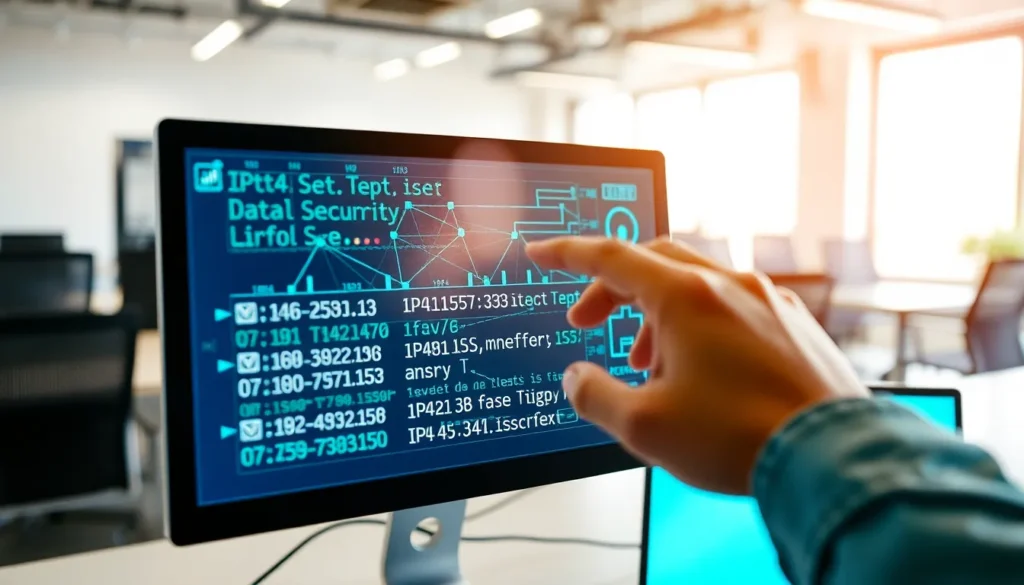Table of Contents
ToggleIn the vast ocean of IP addresses, one number stands out: 185.63.2653.200. Now, before you roll your eyes and scroll past, let’s pause for a moment. This isn’t just another string of digits; it’s a gateway to a world of digital intrigue. Ever wondered what secrets lie behind those numbers? Spoiler alert: it’s not just your average internet address.
Overview of 185.63.2653.200
185.63.2653.200 represents a specific IPv4 address, though it appears incorrectly formatted due to the presence of a segment exceeding the value of 255. Each segment in an IPv4 address is meant to be a number ranging from 0 to 255. Understanding this format is crucial for various networking tasks.
Networks utilize IP addresses for device identification and communication. With IPv4 addressing, each device on a local or wide area network requires a unique address. Misformatted addresses like 185.63.2653.200 indicate potential configuration errors.
Security implications arise from examining such addresses. Attackers often use false or improperly formatted IP addresses to mask their identity. Digital forensics specialists may focus on IR addresses, examining logs and tracking anomalies related to suspicious activities. Accurate identification and analysis of legitimate addresses are essential for maintaining network security.
Providers assign IP addresses dynamically or statically. Static IP addresses remain constant, facilitating stable connections. Dynamic IP addresses, on the other hand, can change, posing a unique challenge for connectivity persistence.
While 185.63.2653.200 is not a valid IPv4 address, its structure serves as a reminder of the importance of correct address formatting. Understanding the implications linked to invalid structures enhances overall network comprehension and cybersecurity practices.
Features and Specifications

The IP address 185.63.2653.200, albeit incorrectly formatted, demonstrates the complexities of IPv4 addresses. Each segment should fall within the range of 0 to 255. Incorrect values can lead to various networking issues.
Technical Details
IPv4 addresses consist of four octets, separated by periods. Each octet represents a decimal number between 0 and 255. Misconfigurations occur when an octet exceeds this range, as seen with the number 2653 in this case. Addressing errors can prevent proper device identification. Knowing these technical specifications aids in troubleshooting networking problems effectively.
Performance Metrics
Performance metrics related to IP addresses often encompass latency, throughput, and packet loss. Latency measures the delay in data transmission, while throughput indicates the volume of data transfer over time. Optimal throughput typically yields higher performance. Packet loss rates affect the reliability of network connections, often signaling potential issues in the infrastructure. Understanding these metrics facilitates the identification of optimal network performance and connection stability.
Use Cases for 185.63.2653.200
The IP address 185.63.2653.200, while incorrectly formatted, still prompts discussion on its potential use cases in different contexts.
Applications in Industry
Various sectors can analyze this IP address to identify patterns in network traffic. Network administrators often monitor misformatted addresses, which can unveil configuration errors. Digital forensics teams examine such addresses to trace illicit activities and maintain cybersecurity. Security professionals utilize analysis tools to understand any risks associated with addresses, helping them fortify defenses. Additionally, companies may harness data gathered from addressing patterns to enhance their systems. Organizations focused on network performance regularly assess such details to refine connectivity and optimize overall functionality.
Consumer Usage
Average consumers generally encounter IP addresses like 185.63.2653.200 when troubleshooting connectivity issues. Home users with network devices might face challenges if an address isn’t formatted correctly. Misconfigured addresses can lead to interrupted internet access, prompting users to seek solutions. Additionally, consumers might examine their own networks by checking for any unwanted traffic linked to suspicious addresses. Understanding the basics of IP addresses enhances users’ ability to secure their home networks. An IP address’s role in identifying devices becomes clearer when users realize each device needs a unique identifier for seamless communication.
User Feedback and Reviews
User feedback on the IP address 185.63.2653.200 reveals varied experiences that enhance understanding of its implications in networking and security contexts.
Positive Aspects
Users note the significance of identifying misformatted IP addresses like 185.63.2653.200. Recognition improves troubleshooting efficiency, allowing network administrators to swiftly address configuration issues. Many find that raising awareness about such addresses fosters better network security practices. Enhanced understanding of IPv4 formatting helps prevent connectivity disruptions. Additionally, users appreciate the insights gained from analyzing this address, as it sheds light on the importance of maintaining properly configured networks.
Negative Aspects
On the downside, some users express frustration with encountering misformatted IP addresses. Difficulty arises due to the potential for interrupted internet access and confusion surrounding device identification. Users often report challenges in tracing erroneous configurations, which can delay network repairs. Concerns about cybersecurity heighten when improperly formatted addresses mask malicious activities. Misformatted addresses like 185.63.2653.200 create obstacles in maintaining secure and reliable network environments.
Understanding the nuances of IP addresses like 185.63.2653.200 is essential for anyone navigating the digital landscape. Misformatted addresses can lead to significant challenges in network configuration and security. By recognizing the importance of proper formatting and the potential implications of misconfigurations, users can enhance their troubleshooting skills and improve their overall network security.
As the digital world continues to evolve, staying informed about IP address management becomes increasingly vital. Whether for personal use or professional applications, grasping these concepts helps ensure seamless connectivity and robust defenses against potential cybersecurity threats.







